My Memories of Lou Harrison Part II
Part II of My Memories of Lou Harrison by Jain Fletcher
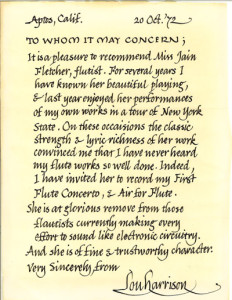
In my last year of school, I started trying to make plans to go to New York, but with my chronic lack of funds, my chances were not looking very promising. At around that same time, Lou told me he was being asked to make a tour of New York state with his small group (Bill Colvig and Richard Dee) and, since I was “going to New York anyway” he had some music for violin (ossia flute) and drone that he thought would be nice to have me play on the concerts. I could not imagine saying “no” to this unbelievable opportunity, so I happily agreed. To prepare for our tour, we spent at least 3 weekend days at Lou’s and Bill’s place in Cabrillo, practicing the music for the concert. After that, we would have a little dinner before I coaxed my ’56 VW back over the Santa Cruz mountains to San Jose.
Practicing for the concert was very special, indeed, but I treasure even more the chance I got to be with Lou and his friends in his and Bill’s very colorful and comfortable home. The most pleasant part of those dinners was the stories they would tell. My most vivid memory of those stories was this one time when Bill and Lou regaled me over dinner with their recent adventure at a local hardware store trying out various metallic canisters to be used as “drums” (such as galvanized steel garbage cans) or beaters (such as hammers and large bolts, etc.) for a piece they were going to be staging soon. I could not help imagining the look on other shoppers’ faces when they saw two men pulling several garbage can lids out into the aisles to test their sound qualities–all the while engaged in a spirited discussion of their relative merits. When I registered both my delight and amazement at this story, they assured me that they had long since managed to garner the proprietor’s “blessing” for this activity. I also remember how much Lou shared of himself at his house. I remember asking one evening about how he got such beautiful handwriting. He not only told me how he got his start at calligraphy (which I have managed to forget after all these years), but he also gave me my first impromptu calligraphy “lesson”. He wanted to show me how “easy” it was to make the strokes, first by showing me, then by letting me try. My results could not have been much more than scribbles at the time, but his lesson “took”, because it gave me the courage to continue. About three years later (when I was working in a book and art supplies store), I had my first real chance to learn some calligraphy–and I have practiced it since. Not to either Lou’s or Ron’s level, mind you, but it pleases me anyway…
Festival program book opportunities for Ojai businesses and beyond
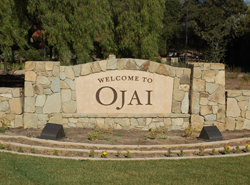
A significant part of the Ojai Music Festival’s legacy and ‘aura’ is its idyllic setting. When When John Bauer first laid eyes on Ojai some 67 years ago, he knew that the Ojai Valley would be the perfect location for an emerging festival for the arts.
To this day, Ojai continues to charm not only audience members, but Festival artists who equally fall in love with the intimate, outdoor setting of the Libbey Bowl as well as the eclectic small town and bucolic surroundings.
Indeed, the Festival is fortunate to have a backyard of beauty, plus a very supportive community from the residents to the businesses.
The many businesses – from lodging, restaurants and art galleries to shops, spas and coffee shops, participate in many ways including advertising in the hefty program book, written eloquently by musicologist Christopher Hailey. Although the Festival has other ad partners outside of the Ojai community, it is the local businesses that support the must-read program book that patrons read fiendishly during the Festival and keep even after the Festival as a memento!
View our list of local eateries here > >
Find things to do in Ojai during Festival or year round >>
Are you a business looking to “win over” a highly –desirable group of arts patrons?
View our media kit, which includes rates and audience demographics >>
Ojai’s Crown Jewel: Ojai Valley Inn & Spa
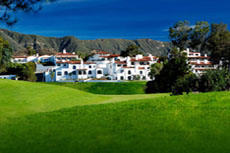 905 Country Club Rd
905 Country Club Rd
Phone: 805 646 1111
Website: OjaiResort.com
Often cited as one of the top resorts in the country, the famed Ojai Valley Inn & Spa offers a complete vacation experience, featuring luxurious rooms, extensive spa services, a variety of delicious restaurants, and a picturesque golf course, all surrounded by stunning views of the Topa Topa mountains and Ojai’s pink moment. Conveniently located a 10 minute walk from Libbey Bowl (or an even shorter bike ride), the Ojai Valley Inn is connected to the Libbey Bowl and downtown Ojai by the Ojai Valley Trail.
Festival patrons receive as special room rate at the Inn. Click here to book online or use group code MUSIC when making your reservation.
The Oakridge Inn
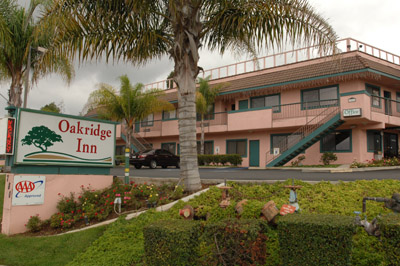
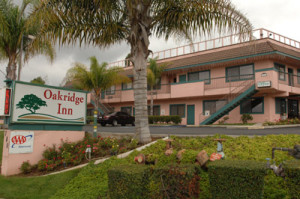 780 North Ventura Avenue
780 North Ventura Avenue
Phone: 805 649 4018
Website: Oakridgeinn.com
If you’re looking for another lodging alternative in the Ojai Valley during Festival weekend, The Oakridge Inn is just the place for you. The Oakridge Inn is located in Oak View, a small Ojai Valley community nestled among spreading oaks, surrounded by tree-covered mountains, beautiful parks, museums, historical sites, and recreational facilities.
[nggallery id=1 template=caption]
Click on a photo to view or download a high-res version using the links above.
Contact Gina Gutierrez or call 805 646 2094 ext. 104 for additional images.
Inuksuit, John Luther Adams, and Ojai
Just before the new year, influential music critic Alex Ross released several end of year lists. He named the Festival’s own Thomas Morris as one of the Persons of the Year, and released his list of the greatest performances of 2011. One of the selected highlights was the performance of John Luther Adams’ “Inuksuit” at the Park Avenue Armory in New York. Written for Steve Schick, Inuksuit–the title is derived from the stone cairns used by the indigenous peoples of the Arctic–is an arresting piece for 9-99 percussion performers who are located throughout a large space (it was originally intended to be performed outdoors), allowing audience members to remain stationary or to move through the performers at will. Watch excerpts from the Armory performance.
Lucky for us, we don’t have to travel to New York to witness Inuksuit. The 2012 Festival will kick off with the piece’s West Coast premiere on Thursday Evening at 5pm. The premiere will be a free community performance featuring 48 percussionists led by Steven Schick, including professional musicians, music students from Southern California universities and colleges, and local musicians from Ojai. They will be placed throughout Libbey Park and Bowl to create a truly unique, interactive musical experience.
Luther Adams is no stranger to such intersections and interactions between space and sound. Described by the New Yorker as “one of the most original musical thinkers of the 21st century,” his works take the vast natural landscapes and the indigenous cultures of his adopted Alaska as their inspiration. Spurred by his deep interest in environmental conservation, Luther Adams’ compositions create a bridge between human experience and the natural world, bringing audiences greater awareness and a heightened connection with nature. Many of his works take their material directly from nature itself. In The Place Where You Go To Listen, for instance, Luther Adams used seismological readings and geophysical data in composing.
In many ways Luther Adams’ compositions are a perfect fit for the outdoor setting of Libbey Bowl, and the 2012 Festival will feature several of his works. After Inuksuit on Thursday, the evening concert will also feature Red Arc/Blue Veil, performed by Marc-André Hamelin and Steve Schick. Luther Adams’ work returns on Sunday night, where Leif Ove Andsnes will join Hamelin to perform Dark Waves. Click here to listen to a preview.
This year’s Festival is promising to be a truly unique intersection of music, place, and idea. If you have not yet purchased your tickets for this year’s Festival, you can do so online, or by calling 805.646.2053.
For more information on John Luther Adams and to read his writing on music, composition, and the environment, visit his website.
Confessions of a Teenage ‘Metro Gnome’
György Ligeti’s fluxus score to ‘Poème Symphonique’ spends little time discussing the performance of the work itself. Instead, he addresses a more pressing matter: acquiring 100 metronomes. Music stores, newspaper advertisements, and Maecenas are some of the sources that Ligeti encourages to bribe with program note recognition etc. If a rich patron were to simply buy Ligeti 100 metronomes, the piece would be “dedicated to him alone.”
When Artistic Director Tom Morris pitched the project to me in 2007, he lowered the cone of silence. “We’ve located the metronomes, but now I need you to assemble a team to set them off at the opening night concert.” Six cardboard boxes of time-keeping devices had just arrived from a performance of ‘Poème Symphonique’ in Austin, Texas. We were armed and ready.
Ten tables with ten metronomes each ringed the bowl at the opening night concert. Pianists Amy Williams and Helena Bugallo gave the signal to my team and the clicking commenced. While the sound of one metronome is regular and percussive, multiplied one hundred times, the result is quite different—imagine rain on a tin roof. But one by one, the upward pendulums froze until the heroic last stand of the final metronome. Beats away from death, the wooden pyramid hypnotized the audience. A long pause was observed when the last click sounded.
Albert Behar is a composer and past intern at the Ojai Music Festival. He is currently running around Paris with an accordion in search of jazz manouche. To find out more about his French alter-ego visit: http://accordion.albertbehar.com
